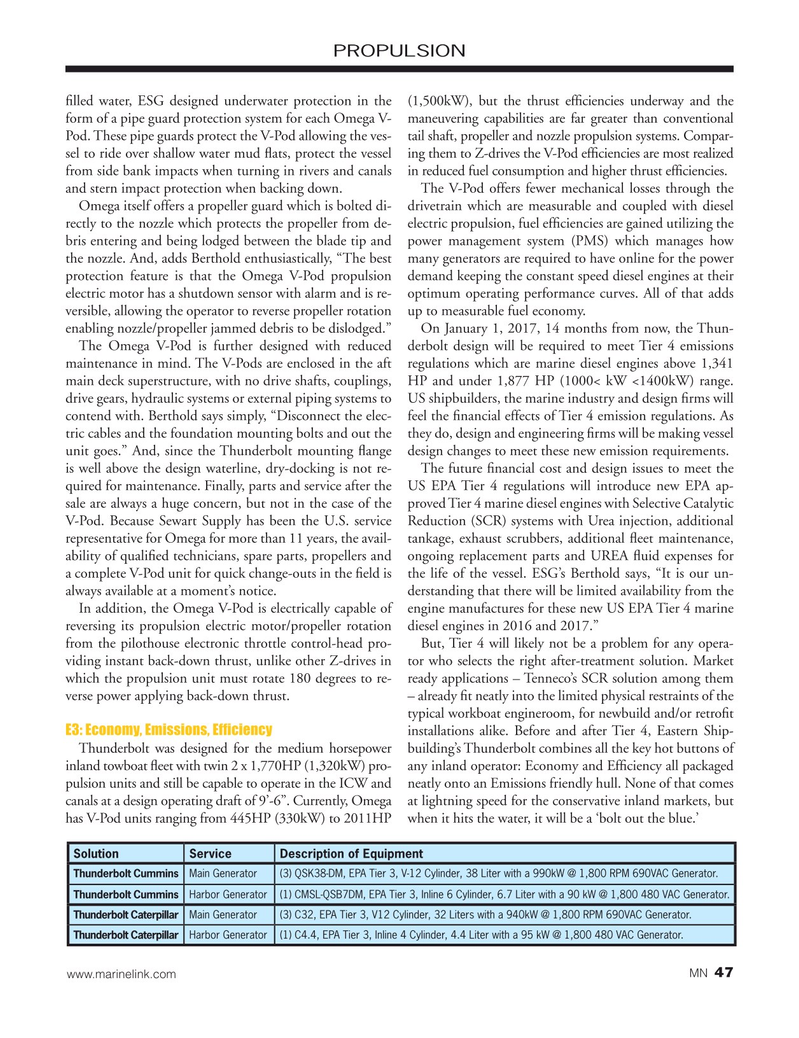
Page 47: of Marine News Magazine (October 2015)
Salvage & Spill Response
Read this page in Pdf, Flash or Html5 edition of October 2015 Marine News Magazine
PROPULSION ? lled water, ESG designed underwater protection in the (1,500kW), but the thrust ef? ciencies underway and the form of a pipe guard protection system for each Omega V- maneuvering capabilities are far greater than conventional
Pod. These pipe guards protect the V-Pod allowing the ves- tail shaft, propeller and nozzle propulsion systems. Compar- sel to ride over shallow water mud ? ats, protect the vessel ing them to Z-drives the V-Pod ef? ciencies are most realized from side bank impacts when turning in rivers and canals in reduced fuel consumption and higher thrust ef? ciencies.
and stern impact protection when backing down. The V-Pod offers fewer mechanical losses through the
Omega itself offers a propeller guard which is bolted di- drivetrain which are measurable and coupled with diesel rectly to the nozzle which protects the propeller from de- electric propulsion, fuel ef? ciencies are gained utilizing the bris entering and being lodged between the blade tip and power management system (PMS) which manages how the nozzle. And, adds Berthold enthusiastically, “The best many generators are required to have online for the power protection feature is that the Omega V-Pod propulsion demand keeping the constant speed diesel engines at their electric motor has a shutdown sensor with alarm and is re- optimum operating performance curves. All of that adds versible, allowing the operator to reverse propeller rotation up to measurable fuel economy.
enabling nozzle/propeller jammed debris to be dislodged.” On January 1, 2017, 14 months from now, the Thun-
The Omega V-Pod is further designed with reduced derbolt design will be required to meet Tier 4 emissions maintenance in mind. The V-Pods are enclosed in the aft regulations which are marine diesel engines above 1,341 main deck superstructure, with no drive shafts, couplings, HP and under 1,877 HP (1000< kW <1400kW) range. drive gears, hydraulic systems or external piping systems to US shipbuilders, the marine industry and design ? rms will contend with. Berthold says simply, “Disconnect the elec- feel the ? nancial effects of Tier 4 emission regulations. As tric cables and the foundation mounting bolts and out the they do, design and engineering ? rms will be making vessel unit goes.” And, since the Thunderbolt mounting ? ange design changes to meet these new emission requirements. is well above the design waterline, dry-docking is not re- The future ? nancial cost and design issues to meet the quired for maintenance. Finally, parts and service after the US EPA Tier 4 regulations will introduce new EPA ap- sale are always a huge concern, but not in the case of the proved Tier 4 marine diesel engines with Selective Catalytic
V-Pod. Because Sewart Supply has been the U.S. service Reduction (SCR) systems with Urea injection, additional representative for Omega for more than 11 years, the avail- tankage, exhaust scrubbers, additional ? eet maintenance, ability of quali? ed technicians, spare parts, propellers and ongoing replacement parts and UREA ? uid expenses for a complete V-Pod unit for quick change-outs in the ? eld is the life of the vessel. ESG’s Berthold says, “It is our un- always available at a moment’s notice. derstanding that there will be limited availability from the
In addition, the Omega V-Pod is electrically capable of engine manufactures for these new US EPA Tier 4 marine reversing its propulsion electric motor/propeller rotation diesel engines in 2016 and 2017.” from the pilothouse electronic throttle control-head pro- But, Tier 4 will likely not be a problem for any opera- viding instant back-down thrust, unlike other Z-drives in tor who selects the right after-treatment solution. Market which the propulsion unit must rotate 180 degrees to re- ready applications – Tenneco’s SCR solution among them verse power applying back-down thrust. – already ? t neatly into the limited physical restraints of the typical workboat engineroom, for newbuild and/or retro? t
E3: Economy, Emissions, Ef? ciency installations alike. Before and after Tier 4, Eastern Ship-
Thunderbolt was designed for the medium horsepower building’s Thunderbolt combines all the key hot buttons of inland towboat ? eet with twin 2 x 1,770HP (1,320kW) pro- any inland operator: Economy and Ef? ciency all packaged pulsion units and still be capable to operate in the ICW and neatly onto an Emissions friendly hull. None of that comes canals at a design operating draft of 9’-6”. Currently, Omega at lightning speed for the conservative inland markets, but has V-Pod units ranging from 445HP (330kW) to 2011HP when it hits the water, it will be a ‘bolt out the blue.’
Solution ServiceDescription of Equipment
Thunderbolt Cummins Main Generator(3) QSK38-DM, EPA Tier 3, V-12 Cylinder, 38 Liter with a 990kW @ 1,800 RPM 690VAC Generator.
Thunderbolt Cummins Harbor Generator(1) CMSL-QSB7DM, EPA Tier 3, Inline 6 Cylinder, 6.7 Liter with a 90 kW @ 1,800 480 VAC Generator.
Thunderbolt Caterpillar Main Generator(3) C32, EPA Tier 3, V12 Cylinder, 32 Liters with a 940kW @ 1,800 RPM 690VAC Generator.
Thunderbolt Caterpillar Harbor Generator(1) C4.4, EPA Tier 3, Inline 4 Cylinder, 4.4 Liter with a 95 kW @ 1,800 480 VAC Generator.
47 www.marinelink.com MN
MN Oct15 Layout 32-49.indd 47 9/21/2015 11:28:01 AM

 46
46

 48
48
